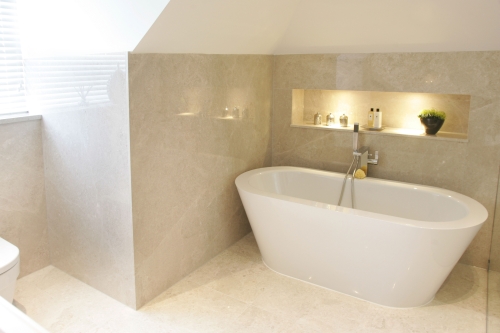Bath
Contents |
[edit] Introduction
A bath (sometimes referred to as a bathtub or tub) is a large container for water that can be used for immersing or washing a person's body (or sometimes other objects). NB A bath can also be a type of appliance that is used to collect and remove water (by way of an overflow or waste drain) once it has been used.
[edit] History
Evidence of the ritual act of bathing dates back to ancient times. This act typically took place in communal bath houses.
Early versions of personal baths supplied by water pipes (rather than buckets of water that have been carried) have been found in Ancient Greece. The baths were made from clay or ceramic and supplied by copper pipes.
The Ancient Romans developed a form of heating water for baths which used hot materials such as rocks. The heated water was then poured into the bath.
Advances in the manufacture of the bath took place in the 18th century. This came with the adoption of cast iron, tin and copper as a suitable material for stand alone baths. These devices were primarily used by the aristocracy and became more elaborately designed and decorated.
They were also manufactured from porcelain (a ceramic material made from clay that might be described as 'vitreous china' when coated with enamel). This might be referred to as ceramic, porcelain or china sanitaryware and is often white, with the incorporation of porcelain enamel coatings.
In the 20th century, smaller spaces and increased demand drove the introduction of more utilitarian baths. These baths were built in rather than stand alone units that were eventually made from lighter materials that were less expensive to produce and easier to maintain.
[edit] Types of baths
Modern baths are made from a wide range of materials, including coated metals, cast iron, steel, acrylics, fibreglass and so on. They can be produced in a variety of shapes and colours, although they are typically rectilinear and long enough to accommodate a person who is in a reclined position.
There are several different types of installed or stand alone baths. These can include:
- Accessible (including walk-in or gated versions).
- Clawfoot and pedestal.
- Corner baths.
- Drop-in baths.
- Freestanding.
- Recessed or alcove.
- Soft baths.
- Steel baths.
- Shower baths.
- Sunken bath.
- Whirlpool baths or spa tubs.
[edit] Building regulations
The Building Regulations Approved Document G: Sanitation, hot water safety and water efficiency suggests that a bath is a type of sanitary appliance or sanitary ware that is further described as part of a bathroom (‘…a room containing a bath or shower and, in addition, can also include sanitary accommodation.')
Approved Document G prescribes maximum water consumption limits for baths and a maximum water temperature.
Approved Document M – Access to and Use of Buildings, includes minimum requirements for space available around a bath.
Additional requirements for drainage are set out in Approved Document H: drainage and waste disposal.
[edit] Related articles on Designing Buildings
Featured articles and news
A change to adoptive architecture
Effects of global weather warming on architectural detailing, material choice and human interaction.
How big is the problem and what can we do to mitigate the effects?
Overheating guidance and tools for building designers
A number of cool guides to help with the heat.
The UK's Modern Industrial Strategy: A 10 year plan
Previous consultation criticism, current key elements and general support with some persisting reservations.
Building Safety Regulator reforms
New roles, new staff and a new fast track service pave the way for a single construction regulator.
Architectural Technologist CPDs and Communications
CIAT CPD… and how you can do it!
Cooling centres and cool spaces
Managing extreme heat in cities by directing the public to places for heat stress relief and water sources.
Winter gardens: A brief history and warm variations
Extending the season with glass in different forms and terms.
Restoring Great Yarmouth's Winter Gardens
Transforming one of the least sustainable constructions imaginable.
Construction Skills Mission Board launch sector drive
Newly formed government and industry collaboration set strategy for recruiting an additional 100,000 construction workers a year.
New Architects Code comes into effect in September 2025
ARB Architects Code of Conduct and Practice available with ongoing consultation regarding guidance.
Welsh Skills Body (Medr) launches ambitious plan
The new skills body brings together funding and regulation of tertiary education and research for the devolved nation.
Paul Gandy FCIOB announced as next CIOB President
Former Tilbury Douglas CEO takes helm.
UK Infrastructure: A 10 Year Strategy. In brief with reactions
With the National Infrastructure and Service Transformation Authority (NISTA).
Ebenezer Howard: inventor of the garden city. Book review.
Airtightness Topic Guide BSRIA TG 27/2025
Explaining the basics of airtightness, what it is, why it's important, when it's required and how it's carried out.






















